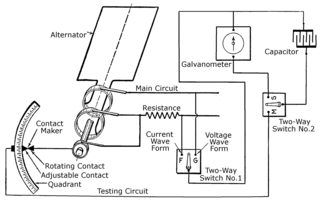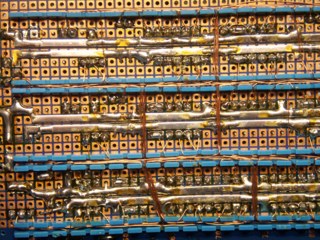 W
WA breadboard, or protoboard, is a construction base for prototyping of electronics. Originally the word referred to a literal bread board, a polished piece of wood used when slicing bread. In the 1970s the solderless breadboard became available and nowadays the term "breadboard" is commonly used to refer to these.
 W
WColdHeat was an American company founded to develop and market products using the proprietary graphite-like compound Athalite. The composite material is claimed by the manufacturer to have the unusual ability to conduct large amounts of heat and return to room temperature in a short amount of time.
 W
WAn oscilloscope, previously called an oscillograph, and informally known as a scope or o-scope, CRO, or DSO, is a type of electronic test instrument that graphically displays varying signal voltages, usually as a calibrated two-dimensional plot of one or more signals as a function of time. The displayed waveform can then be analyzed for properties such as amplitude, frequency, rise time, time interval, distortion, and others. Originally, calculation of these values required manually measuring the waveform against the scales built into the screen of the instrument. Modern digital instruments may calculate and display these properties directly.
 W
WAn electrostatic fieldmeter, also called a static meter is a tool used in the static control industry. It is used for non-contact measurement of electrostatic charge on an object. It measures the force between the induced charges in a sensor and the charge present on the surface of an object. This force is converted to volts, measuring both the initial peak voltage and the rate at which it falls away.
 W
WHeat-shrink tubing is a shrinkable plastic tube used to insulate wires, providing abrasion resistance and environmental protection for stranded and solid wire conductors, connections, joints and terminals in electrical work. It can also be used to repair the insulation on wires or to bundle them together, to protect wires or small parts from minor abrasion, and to create cable entry seals, offering environmental sealing protection. Heat-shrink tubing is ordinarily made of polyolefin, which shrinks radially when heated, to between one-half and one-sixth of its diameter.
 W
WThe history of the oscilloscope reaches back to the first recordings of waveforms with a galvanometer coupled to a mechanical drawing system in the second decade of the 19th century. The modern day digital oscilloscope is a consequence of multiple generations of development of the oscillograph, cathode-ray tubes, analog oscilloscopes, and digital electronics.
 W
WAn IC extractor is a tool for safely and quickly removing integrated circuits (ICs) from their sockets. The main purpose of using this tool is to avoid bending the socket pins and to avoid damage through electrostatic discharge (ESD).
 W
WA multimeter is a measuring instrument that can measure multiple electrical properties. A typical multimeter can measure voltage, resistance, and current, in which case it is also known as a volt-ohm-milliammeter (VOM), as the unit is equipped with voltmeter, ammeter, and ohmmeter functionality. Some feature the measurement of additional properties such as temperature and volume.
 W
WAn oscilloscope, previously called an oscillograph, and informally known as a scope or o-scope, CRO, or DSO, is a type of electronic test instrument that graphically displays varying signal voltages, usually as a calibrated two-dimensional plot of one or more signals as a function of time. The displayed waveform can then be analyzed for properties such as amplitude, frequency, rise time, time interval, distortion, and others. Originally, calculation of these values required manually measuring the waveform against the scales built into the screen of the instrument. Modern digital instruments may calculate and display these properties directly.
 W
WPerfboard is a material for prototyping electronic circuits. It is a thin, rigid sheet with holes pre-drilled at standard intervals across a grid, usually a square grid of 0.1 inches (2.54 mm) spacing. These holes are ringed by round or square copper pads, though bare boards are also available. Inexpensive perfboard may have pads on only one side of the board, while better quality perfboard can have pads on both sides. Since each pad is electrically isolated, the builder makes all connections with either wire wrap or miniature point to point wiring techniques. Discrete components are soldered to the prototype board such as resistors, capacitors, and integrated circuits. The substrate is typically made of paper laminated with phenolic resin or a fiberglass-reinforced epoxy laminate (FR-4).
 W
WPliers are a hand tool used to hold objects firmly, possibly developed from tongs used to handle hot metal in Bronze Age Europe. They are also useful for bending and compressing a wide range of materials. Generally, pliers consist of a pair of metal first-class levers joined at a fulcrum positioned closer to one end of the levers, creating short jaws on one side of the fulcrum, and longer handles on the other side. This arrangement creates a mechanical advantage, allowing the force of the hand's grip to be amplified and focused on an object with precision. The jaws can also be used to manipulate objects too small or unwieldy to be manipulated with the fingers.
 W
WA semiconductor curve tracer is a specialised piece of electronic test equipment used to analyze the characteristics of discrete semiconductor devices such as diodes, transistors, and thyristors. Based on an oscilloscope, the device also contains voltage and current sources that can be used to stimulate the device under test (DUT).
 W
WA soldering iron is a hand tool used in soldering. It supplies heat to melt solder so that it can flow into the joint between two workpieces.
 W
WA spudger or spludger is a tool that has a wide flat-head screwdriver-like end that extends as a wedge, used to separate pressure-fit plastic components without causing damage during separation. The flat end of the spudger is often used to loosen or release components inside electronics, for example during the replacement of batteries or touch screens for smartphones. The other end is often a point or a hook depending on application. When applied to separate pressure-fit panels, there is often a point to create an initial gap before the wedge end is utilized.
 W
WTweezers are small tools used for picking up objects too small to be easily handled with the human fingers. The tool is most likely derived from tongs, pincers, or scissors-like pliers used to grab or hold hot objects since the dawn of recorded history. In a scientific or medical context they are normally referred to as forceps.
 W
WA wiring pencil is a tool for making electrical connections.